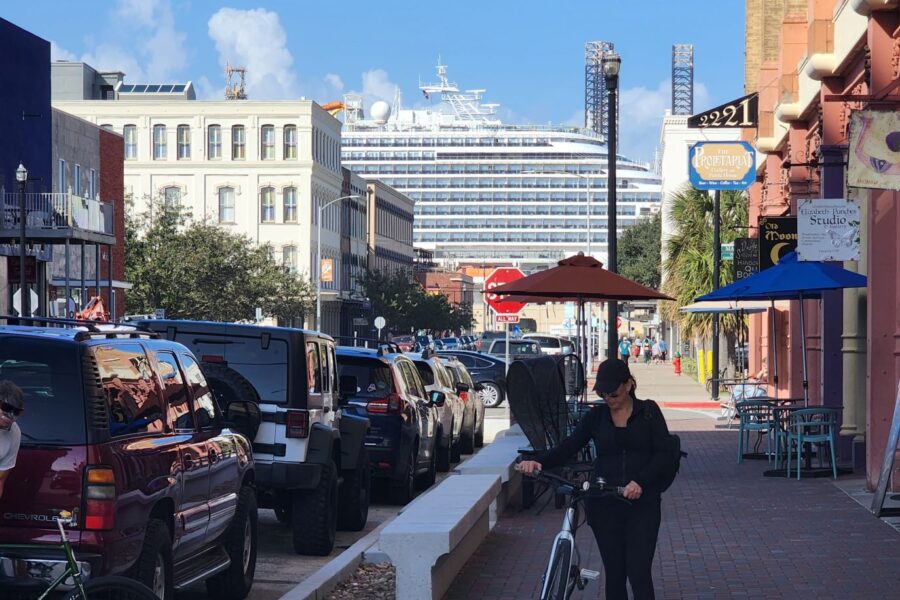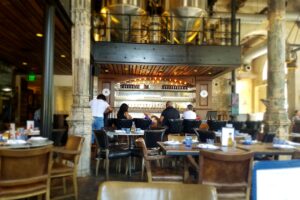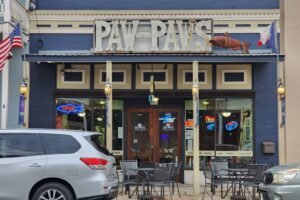Walking down 23rd Street in downtown Galveston it looks like an invasion. An invasion of tourists and cars and monster ships. But today we are here to learn about another invasion, an invasion that took place almost 150 years ago, The Battle of Galveston.
The Tremont Hotel
A Parking Lot with a Story
Our tour guide instructs us to stop. Most of us huddle together in the shade—some of our group stand at the fringe in the sun. Across the street from a parking lot, our tour of the Battle of Galveston begins. This seems an unlikely place to learn anything about the Civil War. Still, I trust our very knowledgeable author, Civil War historian, and preservationist, Ed Cotham, to tell us why we are here.


It seems we are starting at the beginning—the very beginning, perhaps prehistoric beginning — before Texas seceded from the Union. Our small group of history buffs is looking at the site of the original building—the first of three—that housed the elegant Tremont Hotel. Built in 1839, the building was destroyed by fire in 1865. Today, obviously, it is a parking lot.
In between being built and being burned, the original Tremont Hotel is where General Sam Houston delivered his last public speech, warning a hostile crowd of the horrors or war, telling them that “fire and rivers of blood” would be the result if Texas seceded from the Union—and the South would most likely lose in the end. A year later, in the same spot, Texas Governor Francis Lubbock advocated burning Galveston to the ground so Union soldiers would not gain a foothold on our shores as a base for staging an invasion of the rest of Texas.
A Rebirth
Our small group moves on, stopping in front of a low-slung no-nonsense building that is a credit union—and we wonder why we are here. We discover it is the site of the second, larger, and more elaborate Tremont Hotel that opened in 1872.



This reincarnation of the Tremont was also the site of one of the most significant social events of that time when in the spring of 1880, former President and Union General Ulysses S. Grant visited Texas.
As the largest and most prosperous city in Texas back then, huge crowds and celebrities were in Galveston to greet Grant. He stationed himself and his party at the elegant Tremont, where a twenty-three-course dinner was served in his honor. I can’t even imagine—twenty-three courses! I’m sure I misheard, but I am too far back to ask the question. Ed Cotham wrote a book—I should buy it. There are pictures and a menu!
Sadly, fifty-six years after the Tremont opened, the old hotel was derelict and dilapidated. Closing its doors at the end of November, it was raised shortly afterward.
The Battle of Galveston


We cross the street and walk on. Stopping often, we learn about various Generals and their roles during the Civil War in Galveston. I listen, make notes on my phone, and snap pictures of multiple buildings against the brilliant blue sky. The colors are too beautiful and too striking to ignore. The architecture interesting.



Galveston Falls to the Union
Eventually, we reach the Old Galveston Customs and Court House and hear in detail the story of the Battle of Galveston and why we stand in front of this beautiful old building. Cotham tells us we will be here for a while. Everyone looks for a place to relax and sit or lean. Many of us are left standing. This is the interesting part—I’m glad our guide’s voice is amplified.


Galveston fell to the Union in the autumn of 1862. Actually, it sounds like it didn’t fall at all but was gift-wrapped with a red and gray bow and handed over. The commanding general of the Confederate forces, believing Galveston was indefensible, removed all the heavy artillery and ammunition from its shores in anticipation of a Union attack. So, when eight Union ships entered the harbor, a truce was arranged between enemies to safely evacuate Confederate troops to the mainland. The warships held and controlled the harbor until the Union infantry arrived on December 25.
Confederates Fight Back
Under the leadership of a new general, the Confederates entered Galveston Harbor only seven days later, on January 1, opening fire before dawn with intentions of retaking the city. There was a battle. Ships were sunk. Men were wounded—117, and 26 were killed.
The old Customs House was damaged—but not severely. Confederate soldiers took refuge from the cannon fire on the south side of the sturdily constructed building—a cannonball fell in their midst. Within 24 hours, Galveston was back in the hands of the Confederacy and remained that way until the war’s end.


After an hour of listening, walking, and standing, Michael and I are exhausted. War is hard—even hearing about it. After the tour group disperses, we slowly meander back to where we started. Crossing the street, we sit at a table for six—just the two of us—drinking sangria and eating nachos.



To learn more about the battle of Galveston, click on the following link.
https://www.tshaonline.org/handbook/entries/galveston-battle-of









Leave a Reply
Your email is safe with us.